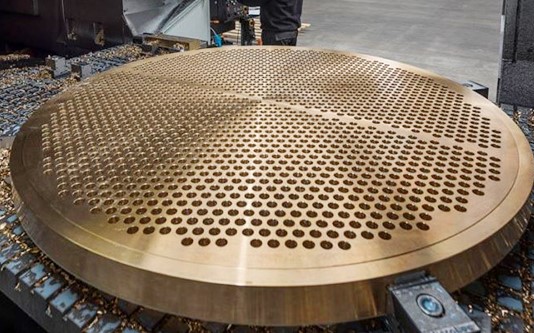Naval Brass Tube Plate Specification For Condensers and Heat Exchangers

Naval Brass Tube Plate
Naval Brass Tube Plate
This specification defines the quality, manufacturing, testing, and acceptance criteria for Naval Brass (C46400) tube plates intended for use in condensers, heat exchangers, and pressure vessels under demanding operational conditions (e.g., high temperature, pressure, and corrosive environments).
Expert Insight: Why Naval Brass for Heat Exchangers?
Naval Brass (UNS C46400) offers exceptional corrosion resistance in marine environments due to its optimized copper-zinc-tin composition. The addition of approximately 1% tin significantly improves resistance to dezincification, making it the preferred choice for seawater-cooled condensers and heat exchangers in naval and offshore applications.
Naval Brass Tube Plate Application Scope
- Primary Use: Fabrication of tube sheets for shell-and-tube heat exchangers, condensers, and marine applications.
- Service Conditions: Suitable for operating temperatures up to 300°C and pressures not exceeding 20 MPa, in contact with seawater, steam, or mildly acidic/alkaline media.
Naval Brass Tube Plate Material Properties
| Property |
Value |
Test Standard |
| Tensile Strength |
≥380 MPa |
ASTM E8/E8M |
| Yield Strength |
≥170 MPa (0.2% offset) |
ASTM E8/E8M |
| Elongation (50mm) |
≥25% |
ASTM E8/E8M |
| Hardness |
120-150 HB |
ASTM E10 |
| Thermal Conductivity |
75 W/m·K |
ASTM E1225 |
Naval Brass Tube Plate Chemical Composition
| Element |
Cu |
Zn |
Sn |
Pb |
Fe |
Others (Total) |
| Min |
59.0 |
Rem. |
0.5 |
– |
– |
– |
| Max |
62.0 |
– |
1.0 |
0.2 |
0.1 |
0.5 |
Naval Brass Tube Plate Manufacturing Process
- Hot Rolling: Initial forming via controlled hot rolling to achieve near-net dimensions.
- Cold Working: Final dimensional adjustments through cold rolling or drawing, followed by stress-relief annealing (650–750°C, air-cooled) to ensure mechanical properties.
- Surface Finish: Free from scale, pits, burrs, and rolling marks. Surface roughness: Ra ≤ 3.2 μm (measured per ASTM D7127).
Naval Brass Tube Plate Quality Control
| Test Type |
Standard |
Frequency |
Acceptance Criteria |
| Ultrasonic Testing |
SA-578M |
100% |
Level B |
| Liquid Penetrant |
ASTM E165 |
Critical areas |
No linear indications |
| Visual Inspection |
ASTM A480 |
100% |
No surface defects |
| Chemical Analysis |
ASTM E1473 |
Per heat + per 4550 kg |
Within composition limits |
Expert Insight: Tube-to-Tubesheet Joint Integrity
For optimal heat exchanger performance, naval brass tube plates require precise hole tolerances (±0.1mm for reamed holes) and proper surface preparation. The combination of naval brass tubes and tube plates ensures compatible thermal expansion and eliminates galvanic corrosion, critical for maintaining joint integrity in thermal cycling applications.
Naval Brass Tube Plate Dimensional Standards
- Thickness Range: 10–50 mm (standard), custom sizes negotiable.
- Width/Length: 1000–3000 mm (width), 2000–6000 mm (length).
- Hole Pattern: Tube hole diameters, pitch, and layout as per purchasers drawings.
- Tolerances: Thickness ±5% of nominal (per ASME SB-171M), flatness ≤1.5 mm/m.
Naval Brass Tube Plate Corrosion Performance
| Environment |
Corrosion Rate (mm/year) |
Performance Rating |
| Seawater (flowing) |
0.025-0.050 |
Excellent |
| Fresh Water |
0.010-0.020 |
Excellent |
| Steam Condensate |
0.005-0.015 |
Excellent |
| Mild Acids (pH 4-6) |
0.030-0.080 |
Good |
Naval Brass Tube Plate Documentation
- Material Test Report (MTR): Includes heat number, dimensions, chemical analysis, mechanical properties, NDT results, and heat treatment records.
- Process Flow Chart: Details melting, rolling, annealing, and inspection stages.
- NDT Reports: UT/PT/MT/RT records with defect maps and operator qualifications.
- Certification of Conformance: Signed declaration of compliance with ASME SB-171M.
Expert Insight: Heat Treatment Optimization
The stress-relief annealing process (650-750°C) is critical for naval brass tube plates. This treatment relieves internal stresses from manufacturing while maintaining the optimal grain structure for both mechanical strength and corrosion resistance. Properly annealed plates demonstrate superior dimensional stability during tube expansion operations.
Naval Brass Tube Plate Applications Comparison
| Application |
Advantages |
Considerations |
| Marine Condensers |
Superior seawater corrosion resistance, biofouling resistance |
Requires proper water velocity control |
| Power Plant Heat Exchangers |
Good thermal conductivity, pressure resistance |
Monitor for ammonia attack in specific environments |
| Offshore Platform Systems |
Proven performance in harsh marine conditions |
Compatible with most cathodic protection systems |
| Shipboard Cooling Systems |
Reliable service life, ease of fabrication and repair |
Optimal in temperatures below 200°C for long-term service |
Naval Brass Tube Plate Industry Standards
- Material Standard: ASME SB-171M (latest edition)
- Chemical Composition: ASTM B171
- Mechanical Testing: ASTM E8/E8M
- NDT Standards: ASME Section V
- Quality Assurance: ISO 9001, ASME NCA-3800


